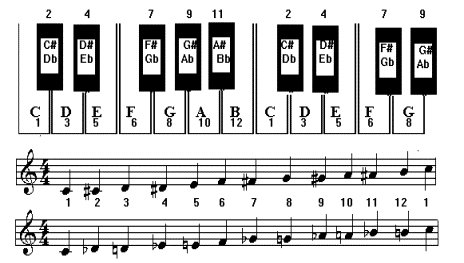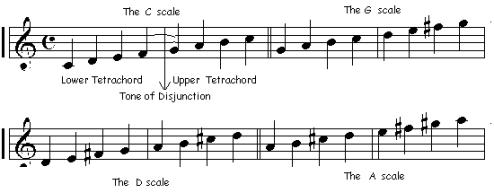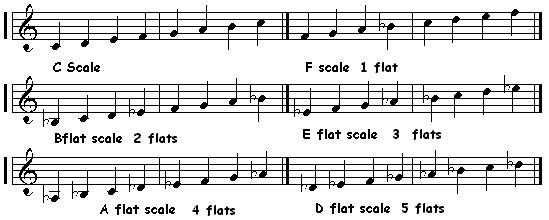When tunes are written in the natural scale, they may sound low, as many of the notes may go below the stave, and use the Leger lines.
In the same way if the same music was written one octave higher, the notes will go out of the stave and leger lines above the stave would be needed.
As the human voice on an average, ranges within the span of the stave, ie. from the first leger line below the stave which carries the do, to the note above the stave, on the space, which carries the higher sol.
The problem of writing the music within this section involves changes for the instrument player, which has fixed note positions. The singer does not realize this, as he does not need to make any calculations, since it happens instinctively. You might have experienced it sometimes, when you have started a song either too high, or too low, and your can not finish it, and you start again lowering of raising your pitch.
Since the distances of notes, one from another are not equidistant, it needs a little study of this phenomenon.
The scale "Do, Re, Mi, Fa, Sol, La, Si, Do" is divided equally into two parts. The first part is Do to Fa.called the lower tetra chord. The other is from Sol to upper Do, which is called the Upper Tetra chord. Both these tetra chords are same in structure. Notes of the Tetra chord: 1 - 2, and 2- 3 are made of one tone (a sound distance measure) and notes 3-4 are half tones, i.e. half the size of the former notes.
The distance in sound measures between the last note of the lower tetra chord and the first note of the upper tetra chord is ONE FULL TONE. As long as this structure is retained by the instrument, one can start playing from any key of the keyboard, but this may require the use of the black keys of the keyboard, which are the notes in between the TONES.

Thus the hymn O Come all ye Faithful, when written on the natural scale extended below the stave, as the lowest note was Sol. and the Highest note too was sol. Sol is the 4th sound below the Tonic Do. Thus if we push the Tonic to F, then the fourth note below will be C.
What changes will be needed then?
Let us divide F to upper F into two tetra chords.
F G A B and C D E F. Note the lower tetra chord. The notes between F and G, and G and A, have black keys in between, so they are Tones. But the sound A to B also is a Tone, and therefore, we will have to lower the B, by half tone, and use the black key to the left of B. Thus we get our lover tetra chord. The upper tetra chord C to F is a normal structure, as it was the lower tetra chord of the Natural Scale. The black key to the left of B is called B flat. See diagram.

These scales require the use of black keys, classified as Sharp keys, as the keys are on the right of the whate key names.

These are the scales which need the black keys to the left of white key names. Note, how when you start a scale on F, you need only one change, on B.
The method of note names for the singers. They still use one name set, the Latin Name set, of Do, Re, Mi.
The reason behind this, is the brain automatically tunes itself to the note names, as it is associated with the name with the sound and the relationship between the individual sounds of the scale remains unchanged, as the person playing the insIf truments makes the necessary changes. Thus, for the singer gets the feeling, that the pitch of the music has been raised, or lowered.
for Singers
|
1 |
2 |
3 |
4 |
5 |
6 |
7 |
8 |
9 |
10 |
11 |
12 |
1 |
|
Do |
Di |
Re |
Ri |
Mi |
Fa |
Fi |
Sol |
Sil |
La |
Li |
Si |
Do |
|
Do |
Ra |
Re |
Ma |
Mi |
Fa |
Sal |
Sol |
Lu |
La |
Sa |
Si |
Do |
The first row has names when sharps appear. The second row has names when flats appear.
If the singers get used to the above name set as they go along the stages of learning, they will be automatically getting used to associating the change in sharps and flats, as they occur in between the music piece.
Use the following exercises, to practice naming these notes. Note how, always, when you find notes on lines, the names are alternate names. Thus, if mi comes on a line, the line above it is sol. If you name the first space, which was called Fa, in the natural scale as your new Do, the space above it is mi. It was the former La. So get used to relating the names with the position of the note in relation to the previous note. This is an important tip, for a successful outcome in your learning process.
O come all ye faithful raised five notes to Sol (G)
The same music raised four notes to F
To download Finale Software go to: http://www.finalemusic.com
| < Prev | Next > |
|---|
















